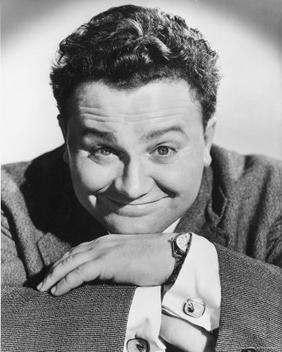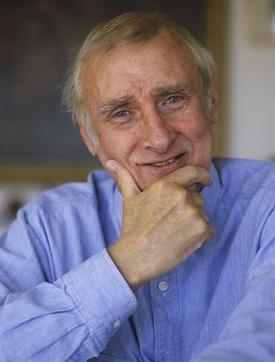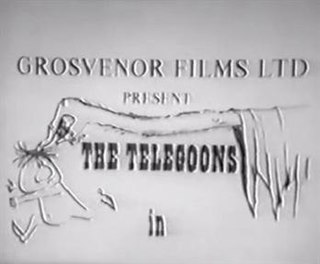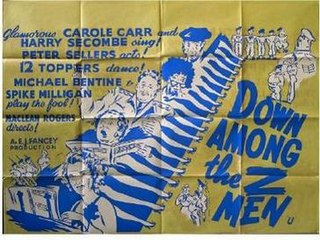Related Research Articles

Sir Harry Donald Secombe was a Welsh actor, comedian, singer and television presenter. Secombe was a member of the British radio comedy programme The Goon Show (1951–1960), playing many characters, most notably Neddie Seagoon. An accomplished tenor, he also appeared in musicals and films – notably as Mr Bumble in Oliver! (1968) – and, in his later years, was a presenter of television shows incorporating hymns and other devotional songs.

Terence Alan "Spike" Milligan was an Irish comedian, writer, musician, poet, playwright and actor. The son of an English mother and Irish father, he was born in British Colonial India, where he spent his childhood before relocating in 1931 to England, where he lived and worked for the majority of his life. Disliking his first name, he began to call himself "Spike" after hearing the band Spike Jones and his City Slickers on Radio Luxembourg.

The Goon Show is a British radio comedy programme, originally produced and broadcast by the BBC Home Service from 1951 to 1960, with occasional repeats on the BBC Light Programme. The first series, broadcast from 28 May to 20 September 1951, was titled Crazy People; subsequent series had the title The Goon Show.
Eccles, also referred to as 'The Famous Eccles' or 'Mad Dan Eccles', is the name of a comedy character, created and performed by Spike Milligan, from the 1950s BBC radio comedy series The Goon Show. In the episode "The Macreekie Rising of '74", Peter Sellers had to fill in for the role in Milligan's absence. Very occasionally, he was referred to as 'Field Marshal' Eccles.
Bluebottle is a comedy character from The Goon Show, a 1950s British comedy radio show. The character was created and performed by Peter Sellers.
Neddie Seagoon was a character in the 1950s British radio comedy show The Goon Show. He was created and performed by Welsh comedian Harry Secombe. Seagoon was usually the central character of a Goon Show episode, with most plots involving or revolving around him.
Hercules Grytpype-Thynne was a character from the British 1950s comedy radio programme The Goon Show. He was voiced by Peter Sellers. In the episode "Who Is Pink Oboe?", Valentine Dyall filled-in for the role in Sellers' absence.
Henry Crun and Minnie Bannister are two characters from the 1950s United Kingdom radio comedy series The Goon Show. Crun and Min were performed by Peter Sellers and Spike Milligan respectively.
Major Denis Bloodnok is a fictional character from the 1950s BBC Radio comedy The Goon Show. He was voiced by Peter Sellers.

The Telegoons is a comedy puppet show, adapted from the highly successful BBC radio comedy show of the 1950s, The Goon Show produced for BBC television and first shown during 1963 and 1964. Two series of 13 episodes were made. The series was briefly repeated immediately after its original run, and all episodes are known to have survived. Harry Secombe, Peter Sellers and Spike Milligan reprised their original voice roles from the radio series and appeared in promotional photos with some of the puppets from the series. Among the puppeteers were Ann Field, John Dudley, and Violet Phelan. The original radio scripts were adapted by Maurice Wiltshire, who had previously co-written a number of radio episodes with Larry Stephens.
This is a list of running jokes and catchphrases in the 1950s British radio programme The Goon Show.

Down Among the Z Men is a 1952 black-and-white British comedy film starring the Goons: Spike Milligan, Peter Sellers, Michael Bentine and Harry Secombe. The movie was filmed early in the Goons' career before many of the show's recurring characters were created, and the stars only play one character each: Eccles (Milligan), Colonel Bloodnok (Sellers), Osric Pureheart (Bentine) and Harry Jones (Secombe).

The Case of the Mukkinese Battle-Horn is a 30-minute comedy film starring Peter Sellers, Spike Milligan and Dick Emery. The film was made in November 1955, and released in 1956.
"The Fear of Wages" is an episode of the British radio comedy The Goon Show, written by Spike Milligan and Larry Stephens. As the 25th episode of the sixth series, it was first broadcast on 6 March 1956 and was among the shows first repeated in the 1970s following the success of The Last Goon Show of All in 1972.
"Any Old Iron" is a British music hall song written by Charles Collins, Fred E. Terry and E.A. Sheppard. Harry Champion sang it as part of his act, and recorded it in 1911.

The Last Goon Show of All is a special edition of the BBC Radio comedy programme The Goon Show commissioned as part of the celebrations of the 50th anniversary of the BBC. Simulcast on radio and television on 5 October 1972, the performance reunited Spike Milligan, Peter Sellers and Harry Secombe as well as other contributors to the programme's original run. It was later released as a long-playing record and on compact disc. The video recording of the television broadcast was also released on VHS and later on DVD, although with some omissions. In early October 2007, 35 years after the original broadcast, a full unedited version was broadcast on BBC 7, the digital radio channel dedicated to re-runs of classic shows.
The "Ying Tong Song" is a novelty song written by Spike Milligan and performed by the Goons, usually led by Harry Secombe. It is a nonsense song, consisting of small verses interspersed by a completely nonsensical chorus. The origin of the title is said to have come from Harry Secombe's mispronunciation of the name of Milligan's war-time friend and fellow jazz musician, Harry Edgington. When Secombe repeatedly called him "Edgerton", Milligan replied, "it's Edgington, Edgington" and emphasized the point by saying "Yington, Yington".
The Histories of Pliny the Elder is a parody of the occupation of Britain by the Romans, from series seven of the 1950s BBC radio comedy, The Goon Show, first broadcast on 28 March 1957.
References
- 1 2 Begg, Paul (2005). Mary Celeste: The Greatest Mystery of the Sea. Pearson Education. p. 95. ISBN 978-0-582-78422-2.
- ↑ Knowles, Elizabeth; Angela Partington (1999). The Oxford Dictionary of Quotations. Oxford University Press US. p. 196. ISBN 978-0-19-860173-9.
- ↑ Behan, Dominic (1988). Milligan: The Life and Times of Spike Milligan. Methuen. p. 30. ISBN 978-0-413-17670-7.
- ↑ Fairley, Alastair; Richard Rogers (2006). De La Warr Pavilion: The Modernist Masterpiece. Merrell. ISBN 978-1-85894-283-4.
- ↑ McIntyre, Dan (2006). Point of View in Plays: A Cognitive Stylistic Approach to Viewpoint in Drama and Other Text-types. J. Benjamins. p. 129. ISBN 978-90-272-3335-6.
- ↑ Jackaman, Rob (1989). The Course of English Surrealist Poetry Since the 1930s. Edwin Mellen Press. p. 264. ISBN 978-0-88946-932-7.
- ↑ Crisell, Andrew (1994). Understanding Radio. Routledge. p. 176. ISBN 978-0-415-10315-2.
- ↑ Gale, Steven H. (1996). Encyclopedia of British Humorists: Geoffrey Chaucer to John Cleese. Taylor & Francis. p. 766. ISBN 978-0-8240-5990-3.